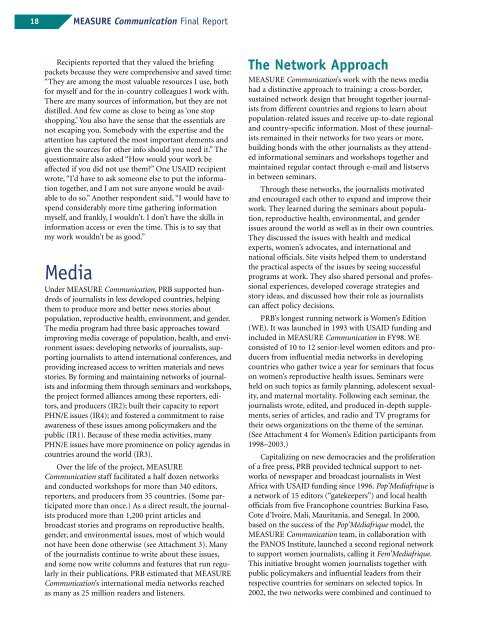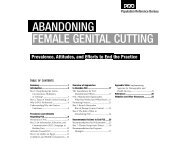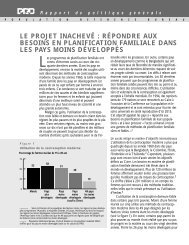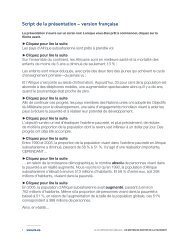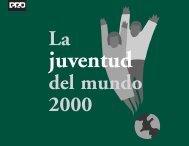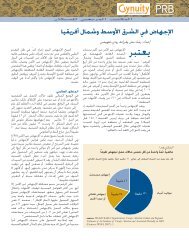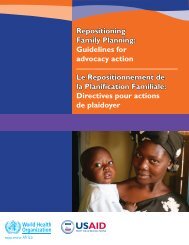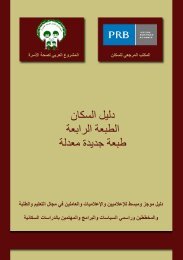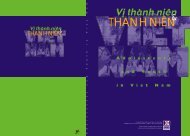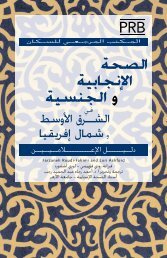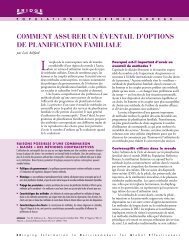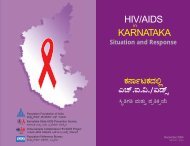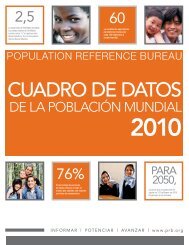MEASURE Communication Final Report - Population Reference ...
MEASURE Communication Final Report - Population Reference ...
MEASURE Communication Final Report - Population Reference ...
Create successful ePaper yourself
Turn your PDF publications into a flip-book with our unique Google optimized e-Paper software.
18 <strong>MEASURE</strong> <strong>Communication</strong> <strong>Final</strong> <strong>Report</strong><br />
Recipients reported that they valued the briefing<br />
packets because they were comprehensive and saved time:<br />
“They are among the most valuable resources I use, both<br />
for myself and for the in-country colleagues I work with.<br />
There are many sources of information, but they are not<br />
distilled. And few come as close to being as ‘one stop<br />
shopping.’ You also have the sense that the essentials are<br />
not escaping you. Somebody with the expertise and the<br />
attention has captured the most important elements and<br />
given the sources for other info should you need it.” The<br />
questionnaire also asked “How would your work be<br />
affected if you did not use them?” One USAID recipient<br />
wrote, “I’d have to ask someone else to put the information<br />
together, and I am not sure anyone would be available<br />
to do so.” Another respondent said, “I would have to<br />
spend considerably more time gathering information<br />
myself, and frankly, I wouldn’t. I don’t have the skills in<br />
information access or even the time. This is to say that<br />
my work wouldn’t be as good.”<br />
Media<br />
Under <strong>MEASURE</strong> <strong>Communication</strong>, PRB supported hundreds<br />
of journalists in less developed countries, helping<br />
them to produce more and better news stories about<br />
population, reproductive health, environment, and gender.<br />
The media program had three basic approaches toward<br />
improving media coverage of population, health, and environment<br />
issues: developing networks of journalists, supporting<br />
journalists to attend international conferences, and<br />
providing increased access to written materials and news<br />
stories. By forming and maintaining networks of journalists<br />
and informing them through seminars and workshops,<br />
the project formed alliances among these reporters, editors,<br />
and producers (IR2); built their capacity to report<br />
PHN/E issues (IR4); and fostered a commitment to raise<br />
awareness of these issues among policymakers and the<br />
public (IR1). Because of these media activities, many<br />
PHN/E issues have more prominence on policy agendas in<br />
countries around the world (IR3).<br />
Over the life of the project, <strong>MEASURE</strong><br />
<strong>Communication</strong> staff facilitated a half dozen networks<br />
and conducted workshops for more than 340 editors,<br />
reporters, and producers from 35 countries. (Some participated<br />
more than once.) As a direct result, the journalists<br />
produced more than 1,200 print articles and<br />
broadcast stories and programs on reproductive health,<br />
gender, and environmental issues, most of which would<br />
not have been done otherwise (see Attachment 3). Many<br />
of the journalists continue to write about these issues,<br />
and some now write columns and features that run regularly<br />
in their publications. PRB estimated that <strong>MEASURE</strong><br />
<strong>Communication</strong>’s international media networks reached<br />
as many as 25 million readers and listeners.<br />
The Network Approach<br />
<strong>MEASURE</strong> <strong>Communication</strong>’s work with the news media<br />
had a distinctive approach to training: a cross-border,<br />
sustained network design that brought together journalists<br />
from different countries and regions to learn about<br />
population-related issues and receive up-to-date regional<br />
and country-specific information. Most of these journalists<br />
remained in their networks for two years or more,<br />
building bonds with the other journalists as they attended<br />
informational seminars and workshops together and<br />
maintained regular contact through e-mail and listservs<br />
in between seminars.<br />
Through these networks, the journalists motivated<br />
and encouraged each other to expand and improve their<br />
work. They learned during the seminars about population,<br />
reproductive health, environmental, and gender<br />
issues around the world as well as in their own countries.<br />
They discussed the issues with health and medical<br />
experts, women’s advocates, and international and<br />
national officials. Site visits helped them to understand<br />
the practical aspects of the issues by seeing successful<br />
programs at work. They also shared personal and professional<br />
experiences, developed coverage strategies and<br />
story ideas, and discussed how their role as journalists<br />
can affect policy decisions.<br />
PRB’s longest running network is Women’s Edition<br />
(WE). It was launched in 1993 with USAID funding and<br />
included in <strong>MEASURE</strong> <strong>Communication</strong> in FY98. WE<br />
consisted of 10 to 12 senior-level women editors and producers<br />
from influential media networks in developing<br />
countries who gather twice a year for seminars that focus<br />
on women’s reproductive health issues. Seminars were<br />
held on such topics as family planning, adolescent sexuality,<br />
and maternal mortality. Following each seminar, the<br />
journalists wrote, edited, and produced in-depth supplements,<br />
series of articles, and radio and TV programs for<br />
their news organizations on the theme of the seminar.<br />
(See Attachment 4 for Women’s Edition participants from<br />
1998–2003.)<br />
Capitalizing on new democracies and the proliferation<br />
of a free press, PRB provided technical support to networks<br />
of newspaper and broadcast journalists in West<br />
Africa with USAID funding since 1996. Pop’Mediafrique is<br />
a network of 15 editors (“gatekeepers”) and local health<br />
officials from five Francophone countries: Burkina Faso,<br />
Cote d’Ivoire, Mali, Mauritania, and Senegal. In 2000,<br />
based on the success of the Pop’Médiafrique model, the<br />
<strong>MEASURE</strong> <strong>Communication</strong> team, in collaboration with<br />
the PANOS Institute, launched a second regional network<br />
to support women journalists, calling it Fem’Mediafrique.<br />
This initiative brought women journalists together with<br />
public policymakers and influential leaders from their<br />
respective countries for seminars on selected topics. In<br />
2002, the two networks were combined and continued to


